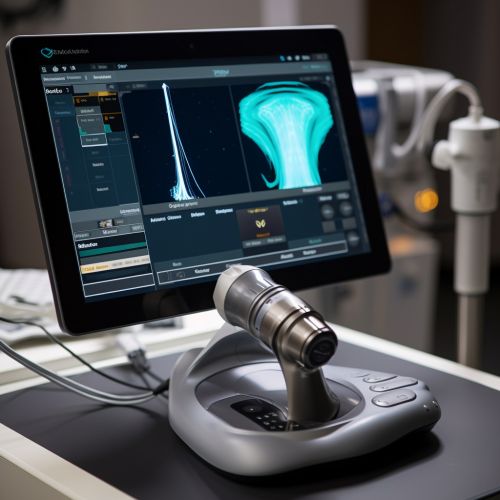Ultrasound
Introduction
Ultrasound is a type of imaging technology that uses high-frequency sound waves to produce images of structures within the body. The term "ultrasound" is derived from the Latin words "ultra", meaning "beyond", and "sonus", meaning "sound". This technology is widely used in various medical fields, including radiology, cardiology, obstetrics, and gynecology, among others.
History
The use of ultrasound for medical purposes dates back to the early 20th century. The first practical application of ultrasound technology was in the field of sonar during World War I. It was not until the 1940s that ultrasound began to be used for medical imaging, with the development of the A-mode (Amplitude mode) ultrasound by Karl Dussik, an Austrian neurologist. This was followed by the development of B-mode (Brightness mode) and M-mode (Motion mode) ultrasounds in the 1950s and 1960s, respectively.


Principles of Ultrasound
Ultrasound imaging works on the principle of the reflection of sound waves. When a sound wave hits a boundary between two different materials, some of the wave is reflected back to the source, while the rest is transmitted into the second material. The reflected waves are then detected by the ultrasound machine, which uses the time it takes for the waves to return to calculate the distance to the boundary. This information is then used to create an image of the structure being examined.
Types of Ultrasound
There are several different types of ultrasound, each with its own specific uses and advantages. These include:
A-mode Ultrasound
A-mode (Amplitude mode) ultrasound is the simplest type of ultrasound. It produces a one-dimensional image, with the amplitude of the reflected waves represented on the vertical axis and the depth of the structure on the horizontal axis.
B-mode Ultrasound
B-mode (Brightness mode) ultrasound produces a two-dimensional image, with the brightness of each point on the image representing the amplitude of the reflected waves. This is the most commonly used type of ultrasound in medical imaging.
M-mode Ultrasound
M-mode (Motion mode) ultrasound is used to study moving structures, such as the heart. It produces a one-dimensional image over time, allowing the motion of the structure to be observed.
Doppler Ultrasound
Doppler ultrasound is used to measure the speed and direction of blood flow. It works by detecting the change in frequency of the reflected waves caused by the motion of the blood cells.
3D and 4D Ultrasound
3D ultrasound produces a three-dimensional image of the structure being examined, while 4D ultrasound adds the element of time, allowing real-time 3D imaging.
Applications of Ultrasound
Ultrasound has a wide range of applications in various medical fields. These include:
Radiology
In radiology, ultrasound is used to image a wide range of structures, including the liver, kidneys, bladder, and other abdominal organs. It can also be used to guide procedures such as biopsies and drainages.
Cardiology
In cardiology, ultrasound is used to image the heart and blood vessels. This is known as echocardiography.
Obstetrics and Gynecology
In obstetrics and gynecology, ultrasound is used to monitor the development of the fetus during pregnancy, as well as to diagnose and treat conditions affecting the female reproductive system.
Other Applications
Other applications of ultrasound include physiotherapy, where it is used to promote tissue healing, and urology, where it is used to image the urinary tract.
Safety and Limitations
While ultrasound is generally considered safe, it does have some limitations. For example, it is not effective at imaging structures filled with air or bone, as these materials reflect most of the sound waves. Additionally, the quality of the image can be affected by the size and body composition of the patient.
